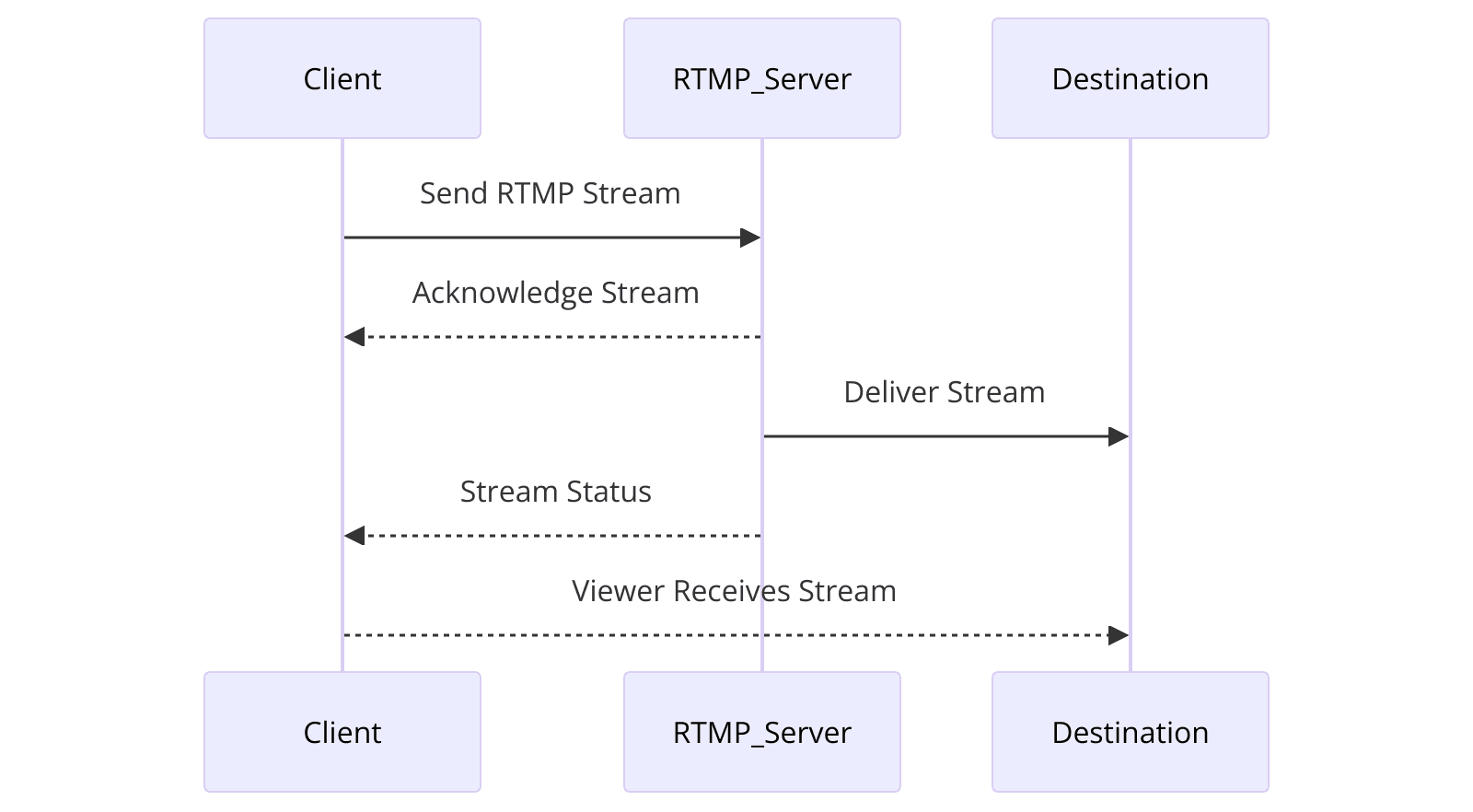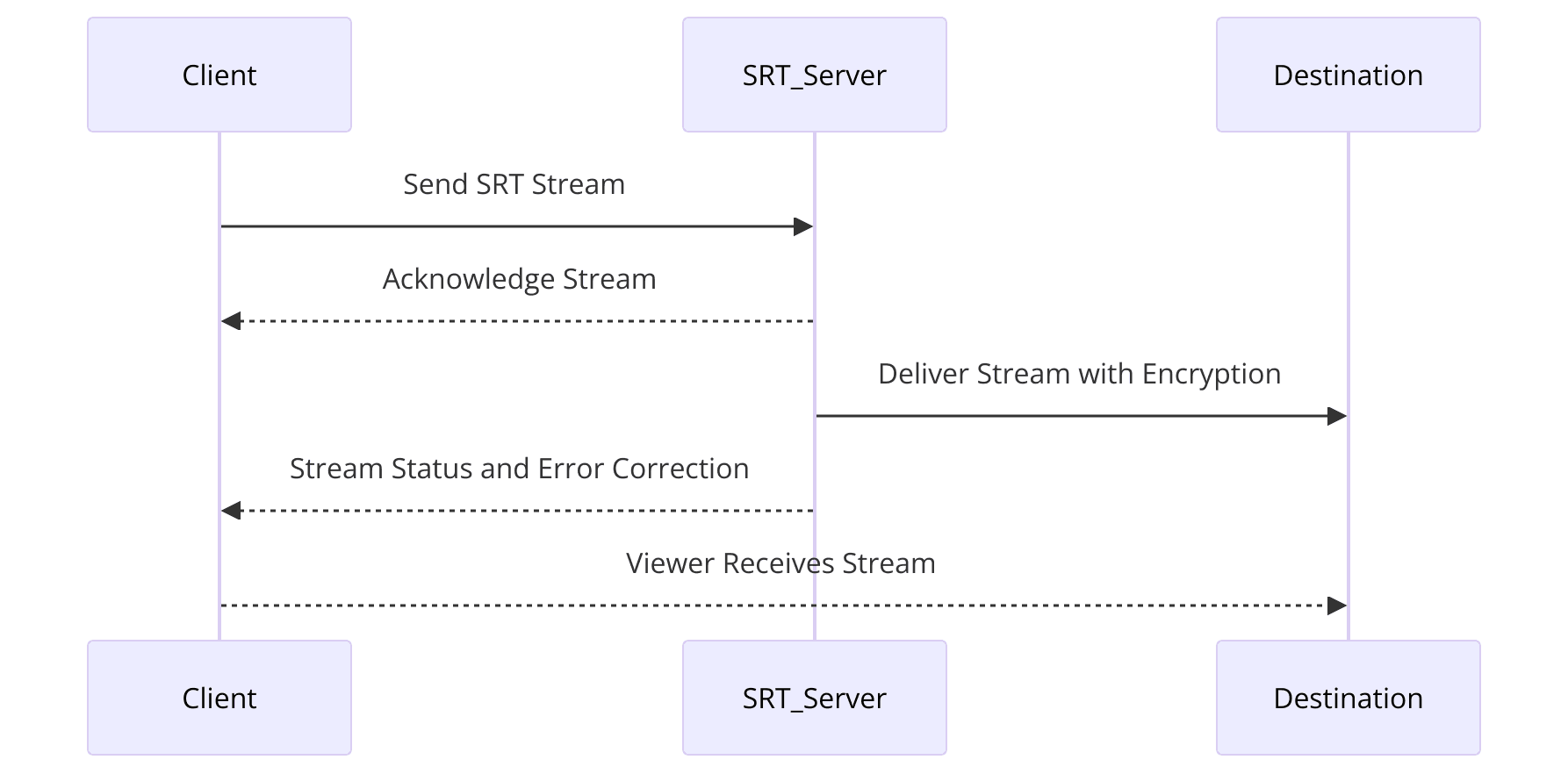What is RTMP (Real-Time Messaging Protocol)?
Real-Time Messaging Protocol
(RTMP) is a communication protocol initially developed by Macromedia (now Adobe) for streaming audio, video, and data over the internet. RTMP was designed to deliver low-latency media streams and became a foundational technology for live streaming, enabling real-time video experiences. Its ability to transmit data efficiently made it a cornerstone for early live streaming platforms.The
communication protocol
breaks down data into smaller packets for efficient delivery, making it ideal for real-time video transmission. This packet breakdown contributes to its low latency. RTMP is commonly used in live streaming with platforms like YouTube, Twitch, and Facebook Live, where immediate data transfer is crucial. For instance, in online gaming, RTMP's low latency ensures minimal delay between player actions and on-screen results.
Advantages of RTMP(Real-Time Messaging Protocol)
RTMP offers several benefits that have cemented its place in live streaming:
Low Latency
RTMP is designed for minimal delay, ensuring that live streams are as real-time as possible. This makes it ideal for applications requiring immediate interaction, such as live broadcasts and interactive events.
Compatibility
RTMP is widely supported across numerous platforms and devices, making it a versatile choice for broadcasters. Its long-standing presence in the industry means it integrates seamlessly with many existing systems.
Established Infrastructure
Given its early adoption, RTMP benefits from a robust infrastructure and a wealth of tools and resources. This ease of use and reliability makes it a go-to for many streaming services.
Limitations of RTMP(Real-Time Messaging Protocol)
Security Issues
RTMP lacks inherent encryption features, making it vulnerable to interception and unauthorized access. This can be a significant concern for sensitive broadcasts. A common vulnerability involves man-in-the-middle attacks where unauthorized parties intercept and potentially alter the stream. While mitigation strategies like tunneling RTMP over SSL/TLS exist, they add complexity and may not fully address all vulnerabilities.
Reliance on Flash:
RTMP relies heavily on Adobe Flash, which has been deprecated and is no longer supported. This reliance limits its future viability and compatibility with modern browsers and devices. This is a significant problem, as modern browsers no longer support Flash, rendering RTMP streams inaccessible without workarounds.
Scaling Limitations
RTMP can struggle with scalability, particularly for high-traffic broadcasts. It requires significant server resources to maintain performance and low latency under heavy loads.
RTMP's Current Role
While RTMP's use has declined with the deprecation of Flash, it still finds use in specific scenarios. Many legacy systems and encoders still support RTMP output. It can also serve as a first-mile contribution protocol, ingesting streams from encoders before transcoding to more modern formats for wider distribution.
RTMP Alternatives
Given the limitations of RTMP, several alternative protocols have emerged as replacements or supplements:
- HLS (HTTP Live Streaming): Developed by Apple, HLS is widely supported and offers good scalability, but typically has higher latency than RTMP.
- WebRTC (Web Real-Time Communication): WebRTC enables real-time communication directly in the browser, ideal for interactive applications, but can be more complex to implement and scale.
- SRT (Secure Reliable Transport): SRT offers low latency, security, and reliability, making it suitable for professional live streaming, even over unstable networks.
- MPEG-DASH: An adaptive bitrate streaming protocol similar to HLS, but not tied to a single vendor.
These alternatives address RTMP's security and Flash-dependency issues while often providing improved scalability and features.
Encoders and Decoders
Popular encoders and decoders commonly used with RTMP include FFmpeg, OBS Studio, and Wirecast. These tools facilitate the encoding of video content into RTMP streams and the decoding of RTMP streams for playback.
What is SRT(Secure Reliable Transport)?
Secure Reliable Transport
(SRT) is an open-source protocol developed by Haivision that focuses on secure, reliable, andlow-latency streaming
of video content over unpredictable networks. SRT streaming is a video streaming protocol designed for low-latency, high-quality video delivery. Using an SRT streaming server, it incorporates robust error correction and encryption mechanisms, making it ideal for professional live streaming in unstable network environments, ensuring secure and reliable transmissions.SRT addresses many of the limitations found in older streaming protocols by incorporating robust error correction and encryption mechanisms. This makes SRT ideal for professional live streaming, particularly in environments where network stability cannot be guaranteed.

Advantages of SRT(Secure Reliable Transport)
SRT brings several innovations to the table:
Enhanced Security
SRT incorporates AES encryption, ensuring that video streams are secure from interception and unauthorized access. This is crucial for broadcasts that require confidentiality.
Low Latency
Similar to RTMP, SRT is designed to maintain low latency. However, it also adapts to network conditions, ensuring smooth playback even when the connection is unstable.
Error Correction
SRT uses packet loss recovery and retransmission techniques to correct errors in real-time. This makes it more reliable for streaming over networks with variable performance.
Limitations of SRT(Secure Reliable Transport)
While SRT offers numerous benefits, it also has some challenges:
Complexity
SRT can be more complex to implement compared to older protocols like RTMP. It requires a deeper understanding of networking and configuration.
Newer Adoption
Being relatively newer, SRT does not have the same level of widespread adoption and established infrastructure as RTMP. This can lead to compatibility issues with certain systems.
Potential Compatibility Issues
Although SRT is growing in popularity, not all platforms and devices support it natively. This can necessitate additional steps to ensure compatibility in a diverse streaming setup.
By understanding the distinct characteristics, advantages, and limitations of RTMP and SRT, broadcasters can make informed decisions about which protocol best suits their needs for live streaming.
Technical Comparison of RTMP vs SRT
Latency Performance
Latency is a critical factor in live streaming, affecting the real-time interaction between the broadcaster and the audience. RTMP is renowned for its low latency, typically maintaining delays of less than 5 seconds.
This low latency is achieved through persistent connections and optimized data packet delivery. However, RTMP's performance can degrade on unstable networks due to its lack of advanced error correction.
While SRT is designed to offer low latency while adapting to network conditions. SRT utilizes advanced techniques such as forward error correction and packet recovery to ensure smooth streaming even over unreliable connections. This adaptability allows SRT to maintain low latency similar to RTMP, but with greater stability and reliability under varying network conditions.
Security Features
Security is another critical aspect where SRT has a significant advantage over RTMP. RTMP lacks built-in encryption, making it susceptible to interception and unauthorized access. Broadcasters often need to implement additional security measures to protect RTMP streams, which can complicate the setup.
On the other hand, SRT offers robust security features out-of-the-box. It incorporates AES encryption, ensuring that video streams are protected against interception and tampering. This built-in security makes SRT a more secure option for transmitting sensitive or high-value content.
Compatibility and Adoption
Compatibility and adoption are crucial when selecting a streaming protocol. RTMP has been the industry standard for many years and is widely supported across various platforms and devices. This extensive compatibility makes RTMP a convenient choice for many broadcasters.
SRT, while newer, is rapidly gaining traction due to its superior performance and security features. However, its adoption is not as widespread as RTMP, and some older platforms and devices may not support it natively. Broadcasters may need to use additional tools or updates to ensure full compatibility with SRT.
Transitioning from RTMP to SRT
Transitioning from RTMP to SRT involves several steps and considerations to ensure a smooth process:
- Evaluate Compatibility: Assess existing infrastructure for compatibility with SRT. This may involve updating or replacing certain hardware and software components to support SRT.
- Configure Network Settings: Optimize network settings to accommodate SRT’s advanced features, such as error correction and encryption.
- Implement Gradually: Consider a phased transition to SRT, starting with less critical streams before fully migrating all live broadcasts.
- Training and Support: Provide training for technical staff to familiarize them with SRT’s configuration and troubleshooting processes.
Steps for Transition:
- Assess and upgrade infrastructure.
- Optimize network settings for SRT.
- Gradually implement SRT in stages.
- Train technical staff on SRT operations.
By understanding the technical distinctions and practical applications of RTMP and SRT, broadcasters can better choose the appropriate protocol for their specific needs.
Explore more about live streaming solutions on VideoSDK.
Practical Examples
Basic RTMP Code Example
Setting up an RTMP stream involves configuring an RTMP server and client. Below is a simple example using Node.js and the
node-media-server package to set up an RTMP server.Node.js RTMP Server Setup
JavaScript
1const NodeMediaServer = require('node-media-server');
2
3const config = {
4 rtmp: {
5 port: 1935,
6 chunk_size: 60000,
7 gop_cache: true,
8 ping: 30,
9 ping_timeout: 60
10 },
11 http: {
12 port: 8000,
13 allow_origin: '*'
14 }
15};
16
17const nms = new NodeMediaServer(config);
18nms.run();
19This basic setup initializes an RTMP server that can accept incoming RTMP streams on port 1935. The server also provides an HTTP interface on port 8000.
Basic SRT Code Example
Setting up an SRT stream involves configuring an SRT server and client. Below is a simple example using Python with the
pysrt library to set up an SRT server.Python SRT Server Setup
Python
1import srt
2import socket
3
4def start_srt_server(ip, port):
5 server_socket = socket.socket(socket.AF_INET, socket.SOCK_DGRAM)
6 server_socket.bind((ip, port))
7
8 print(f"SRT server started on {ip}:{port}")
9
10 while True:
11 data, addr = server_socket.recvfrom(1024)
12 print(f"Received data from {addr}: {data}")
13
14if __name__ == "__main__":
15 start_srt_server("0.0.0.0", 9000)
16This script initializes a basic SRT server that listens for incoming SRT streams on port 9000.
Advanced Integration SRT with Existing Systems
Integrating SRT into an existing RTMP infrastructure can be accomplished by setting up an intermediary server that can handle both protocols. Below is an example configuration using FFmpeg to transcode an incoming RTMP stream to SRT.
FFmpeg RTMP to SRT Transcoding
1ffmpeg -i rtmp://your_rtmp_server/live/stream -c:v libx264 -preset veryfast -maxrate 3000k -bufsize 6000k -c:a aac -b:a 160k -f mpegts srt://your_srt_server:9000?pkt_size=1316
2This command takes an RTMP stream from
your_rtmp_server and transcodes it to an SRT stream, sending it to your_srt_server on port 9000.Conclusion
In this article, we've explored the key differences and similarities between SRT vs RTMP, two prominent streaming protocols. RTMP, with its low latency and widespread compatibility, remains a staple in the live streaming industry. However, its reliance on outdated technology and security limitations are notable drawbacks. SRT, with its robust security features, error correction, and adaptability, is emerging as a strong contender for modern streaming needs, particularly in professional and corporate environments.
By understanding the technical aspects, practical applications, and implementation steps for both protocols, broadcasters can make informed decisions about which protocol best suits their specific requirements. Whether prioritizing compatibility with existing infrastructure or seeking enhanced security and reliability, this guide provides a comprehensive overview to help navigate the evolving landscape of live streaming technology.
Want to level-up your learning? Subscribe now
Subscribe to our newsletter for more tech based insights
FAQ